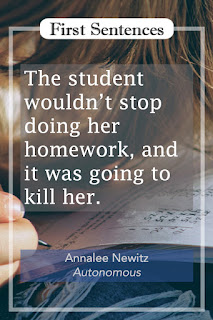Newitz presents a situation and raises the stakes. "It was going to kill her" means that life is on the line. We have a crisis – can anyone save the student's life?
We have one character, the student. As a student, she is likely young. We also know, by her pronoun, that she is female. Both these character traits mark members of society we often feel more protective of, which raises the stakes again.
What else do we know about her? She is doing homework. In other words, she is following the rules, which are part of a system we hope will keep our children safe.
Instead, "homework" is the "it" that "is going to kill her." A normal activity is somehow placing her in danger.
It's another surprise that she "wouldn't stop doing her homework." We expect students to resist doing homework, to put it off, or to rush to finish it so that they can go on to something else. How has it happened that this student won't stop? That's a mystery.
This sentence grabs the reader by creating tension and suspense. Something is wrong when a student won't stop doing homework and the situation is even more critical when the homework threatens the student's life. This sentence is an archetypal hook.
When I started writing about first sentences, I expected to find many hooks. As I went on, I found that a good proportion of the sentences that drew me in offered other enticements. In my mind, I now have three categories, which sometimes overlap. A hook draws me in with immediate conflict. A promise invokes other stories and suggests that if I liked those, I will like this one. A seduction draws me in with its sheer beauty. It's my personal division of a wide world of first sentences. Time will tell whether I still like these categories after another fifty sentences.
Photo by Joshua Hoehne on Unsplash
Graphic elements by Ken Silbert

